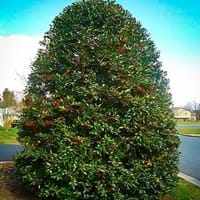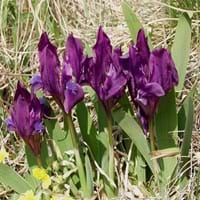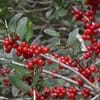Life Span
Perennial
Perennial
Type
Broadleaf Evergreen
Perennial
Origin
Hybrid origin
Eastern Europe
Types
Not Available
Not Available
Habitat
Subtropical climates, Woodland Garden Secondary, Woodlands
Terrestrial
USDA Hardiness Zone
6-9
4-9
AHS Heat Zone
Not Available
9-1
Sunset Zone
21,22
1a, 1b, 2a, 2b, 3a, 3b, 4, 5, 6, 7, 8, 9, 10, 11, 12, 13, 14, 15, 16, 17, 18, 19, 20, 21, 22, 23, 24
Habit
Pyramidal
Clump-Forming
Flower Color
White
Yellow, Lavender, Blue Violet
Flower Color Modifier
Bicolor
Bicolor
Fruit Color
Red, Crimson
Not Available
Leaf Color in Spring
Green, Dark Green
Green, Sea Green
Leaf Color in Summer
Dark Green
Green, Sea Green
Leaf Color in Fall
Dark Green
Green, Sea Green
Leaf Color in Winter
Dark Green
Light Green
Leaf Shape
Pinnate
Lanceolate
Plant Season
Spring, Summer, Fall, Winter
Spring, Summer
Sunlight
Full Sun, Partial Sun, Partial shade, Full Shade
Full Sun, Partial Sun
Type of Soil
Clay, Loam, Sand
Loam, Sand
The pH of Soil
Acidic, Neutral
Neutral
Soil Drainage
Average
Well drained
Bloom Time
Spring
Spring, Late Spring, Early Summer
Tolerances
Drought, Soil Compaction
Drought
Where to Plant?
Ground
Ground
How to Plant?
Rooted stem cutting, Stem Cutting, stem tip cuttings
By dividing rhizomes, tubers, Seedlings
Plant Maintenance
Medium
Medium
Watering Requirements
Average Water Needs, Do not water frequently
Average Water Needs, Do Not over Water
In Summer
Lots of watering
Lots of watering
In Spring
Moderate
Moderate
In Winter
Average Water
Average Water
Soil pH
Acidic, Neutral
Neutral
Soil Type
Clay, Loam, Sand
Loam, Sand
Soil Drainage Capacity
Average
Well drained
Sun Exposure
Full Sun, Partial Sun, Partial shade, Full Shade
Full Sun, Partial Sun
Pruning
Remove damaged leaves, Remove dead branches, Remove dead leaves
Remove damaged leaves, Remove dead branches, Remove dead leaves
Fertilizers
All-Purpose Liquid Fertilizer, Apply N-P-K
All-Purpose Liquid Fertilizer
Pests and Diseases
Leafminers, Mites, Nematodes, Red blotch, Root rot, Tar spot
Red blotch
Plant Tolerance
Drought
Drought
Flowers
Insignificant
Yes
Flower Petal Number
Single
Single
Foliage Texture
Medium
Coarse
Foliage Sheen
Glossy
Matte
Attracts
Birds
Hummingbirds
Allergy
Diarrhea, Mildly Toxic, Vomiting
Skin irritation
Aesthetic Uses
Cottage Garden, Showy Purposes, Used for making hedges
Showy Purposes
Beauty Benefits
Not Available
Not Available
Environmental Uses
Air purification
Air purification
Medicinal Uses
Not Available
No Medicinal Use
Part of Plant Used
Fruits
Not Available
Other Uses
Food for animals, Used for Landscaping
Used as Ornamental plant
Used As Indoor Plant
No
No
Used As Outdoor Plant
Yes
Yes
Garden Design
Feature Plant, Foundation, Hedges, Mixed Border, Screening, Wind Break
Alpine, Edging, Mixed Border, Rock Garden, Wall
Botanical Name
ILEX 'Nellie Stevens'
IRIS pumila
Common Name
Nellie Stevens Holly
Dwarf Iris
In Hindi
Nellie Stevens Holly
Dwarf Iris
In German
Nellie Stevens Holly
Zwergiris
In French
Nellie Stevens Holly
Dwarf Iris
In Spanish
Nellie Stevens Holly
Enano Iris
In Greek
Nellie Stevens Holly
νάνος Ίρις
In Portuguese
Nellie Stevens Holly
Dwarf Iris
In Polish
Nellie Stevens Holly
Dwarf Iris
In Latin
Nellie Stevens Holly
Iris Dwarf
Phylum
Not Available
Magnoliophyta
Class
Not Available
Liliopsida
Order
Aquifoliales
Liliales
Family
Aquifoliaceae
Iridaceae
Clade
Angiosperms, Eudicots
Angiosperms, Monocots
Tribe
Not Available
Irideae
Subfamily
Not Available
Iridoideae
Number of Species
Not Available
Properties of Nellie Stevens Holly and Dwarf Iris
Wondering what are the properties of Nellie Stevens Holly and Dwarf Iris? We provide you with everything About Nellie Stevens Holly and Dwarf Iris. Nellie Stevens Holly has thorns and Dwarf Iris doesn't have thorns. Also Nellie Stevens Holly does not have fragrant flowers. Nellie Stevens Holly has allergic reactions like Diarrhea, Mildly Toxic and Vomiting and Dwarf Iris has allergic reactions like Diarrhea, Mildly Toxic and Vomiting. Compare all the properties and characteristics of these two plants. Find out which of these plant can be used as indoor plant. If you are interested to decorate your house and garden, find out aesthetic uses, compare them and select the plant which will beautify your surrounding. Along with beautification, try comparing medicinal and edible uses of Nellie Stevens Holly and Dwarf Iris and you can choose the plant having best and most benefits.
Season and Care of Nellie Stevens Holly and Dwarf Iris
Season and care of Nellie Stevens Holly and Dwarf Iris is important to know. While considering everything about Nellie Stevens Holly and Dwarf Iris Care, growing season is an essential factor. Nellie Stevens Holly season is Spring, Summer, Fall and Winter and Dwarf Iris season is Spring, Summer, Fall and Winter. The type of soil for Nellie Stevens Holly is Clay, Loam, Sand and for Dwarf Iris is Loam, Sand while the PH of soil for Nellie Stevens Holly is Acidic, Neutral and for Dwarf Iris is Neutral.
Nellie Stevens Holly and Dwarf Iris Physical Information
Nellie Stevens Holly and Dwarf Iris physical information is very important for comparison. Nellie Stevens Holly height is 460.00 cm and width 300.00 cm whereas Dwarf Iris height is 10.20 cm and width 15.20 cm. The color specification of Nellie Stevens Holly and Dwarf Iris are as follows:
Nellie Stevens Holly flower color: White
Nellie Stevens Holly leaf color: Green and Dark Green
Dwarf Iris flower color: Yellow, Lavender and Blue Violet
- Dwarf Iris leaf color: Green and Sea Green
Care of Nellie Stevens Holly and Dwarf Iris
Care of Nellie Stevens Holly and Dwarf Iris include pruning, fertilizers, watering etc. Nellie Stevens Holly pruning is done Remove damaged leaves, Remove dead branches and Remove dead leaves and Dwarf Iris pruning is done Remove damaged leaves, Remove dead branches and Remove dead leaves. In summer Nellie Stevens Holly needs Lots of watering and in winter, it needs Average Water. Whereas, in summer Dwarf Iris needs Lots of watering and in winter, it needs Average Water.





